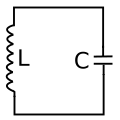LC circuit facts for kids
An LC circuit is an electronic circuit made up of an inductor and a capacitor.
LC circuit's resonant frequency is equal to: 
The angular frequency ω has units of radians per second.
LC circuits are used for creating signals at a particular frequency, or picking out a signal at a particular frequency from a more complex signal. An ideal LC circuit does not have resistance.
At LC circuit energy saves in the capacitor's electric field.

U is energy and q is electric charge. At LC circuit energy also save in the inductor's magnetic field.

U is energy and i is electric current that flows in inductor.
Let's analyze an LC circuit's vibration. Vibrating LC circuit's total energy is U.

Because circuit's resistance is 0, there is no energy that transmits to heat energy, and U is maintained regularity. 
So LC circuit's vibration is shown like that 
First consider the Electrical impedance of the series LC circuit. The total impedance is given by the sum of the inductive and capacitive impedances

By writing the inductive impedance as  and capacitive impedance as
and capacitive impedance as 
-
 .
.
Resultingly the series connected circuit, when connected to a circuit in series, will act as a band-pass filter having zero impedance at the resonant frequency of the LC circuits.
The same analysis may be applied to the parallel LC circuit. The total impedance is then given by

and after substitution of  and
and  we have
we have

which simplifies to
 .
.
Resultingly the parallel connected circuit will act as band-stop filter having infinite impedance at the resonant frequency of the LC circuit.
Images for kids
-
Animated diagram showing the operation of a tuned circuit (LC circuit). The capacitor C stores energy in its electric field E and the inductor L stores energy in its magnetic field B (green). The animation shows the circuit at progressive points in the oscillation. The oscillations are slowed down; in an actual tuned circuit the charge may oscillate back and forth thousands to billions of times per second.
See also
 In Spanish: Circuito LC para niños
In Spanish: Circuito LC para niños




